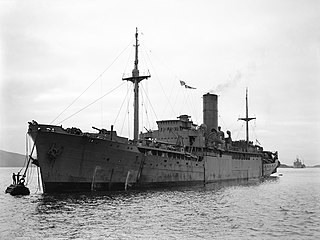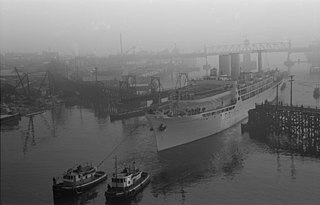
A paddle steamer is a steamship or steamboat powered by a steam engine that drives paddle wheels to propel the craft through the water. In antiquity, paddle wheelers followed the development of poles, oars and sails, where the first uses were wheelers driven by animals or humans.

PS Waverley is the last seagoing passenger-carrying paddle steamer in the world. Built in 1946, she sailed from Craigendoran on the Firth of Clyde to Arrochar on Loch Long until 1973. Bought by the Paddle Steamer Preservation Society (PSPS), she has been restored to her 1947 appearance and now operates passenger excursions around the British coast.

Red Funnel, the trading name of the Southampton Isle of Wight and South of England Royal Mail Steam Packet Company Limited, is a ferry company that carries passengers, vehicles and freight on routes between the English mainland and the Isle of Wight. High-speed foot passenger catamarans, known as Red Jets, run between Southampton and Cowes, while vehicle ferries run between Southampton and East Cowes.

MV Balmoral is a vintage excursion ship owned by MV Balmoral Fund Ltd., a preservation charity. Her principal area of operation is the Bristol Channel, although she also operates day excursions to other parts of the United Kingdom. The Balmoral is included on the National Historic Ships register as part of the National Historic Fleet.

TSMV Shanklin was a passenger ferry that operated between Portsmouth and the Isle of Wight between 1951 and 1980. Renamed Prince Ivanhoe she went on to become a pleasure cruiser in the Bristol Channel but in 1981 sank off the Welsh coast on her first season.
The River Dart Steamboat Co Ltd (RDSC) and its predecessors, the Dartmouth Steam Packet Company and the Dartmouth and Torbay Steam Packet Company, were the major ferry and excursion boat operators on the River Dart in South Devon for 120 years, until the company's demise in 1976. The company was famous for its distinctive paddle steamers, which were a familiar sight on the river until the late 1960s.

Duchess of Norfolk was a 381 GRT paddle steamer built in 1911 for the London, Brighton and South Coast Railway and London and South Western Railway, who operated a joint service to the Isle of Wight. She was requisitioned by the Royal Navy for use as minesweeper HMS Duchess of Norfolk during the First World War, returning to her owners after the war ended. She passed to the Southern Railway on 1 January 1923.

The Great Western Railway's ships operated in connection with the company's trains to provide services to Ireland, the Channel Islands and France. Powers were granted by Act of Parliament for the Great Western Railway (GWR) to operate ships in 1871. The following year the company took over the ships operated by Ford and Jackson on the route between Wales and Ireland. Services were operated between Weymouth, the Channel Islands and France on the former Weymouth and Channel Islands Steam Packet Company routes. Smaller GWR vessels were also used as tenders at Plymouth and on ferry routes on the River Severn and River Dart. The railway also operated tugs and other craft at their docks in Wales and South West England.

TS King Edward was an excursion steamer built at Dumbarton for service down the River Clyde to the Firth of Clyde and associated sea lochs on the west coast of Scotland, as far as Campbeltown. The first commercial vessel to be driven by steam turbines, King Edward operated as a Clyde steamer for half a century from 1901 until 1951, interrupted only by service in the two world wars. The success of the vessel quickly led to the adoption of turbine propulsion for all manner of merchant vessels, from channel ferries and coastal steamers to transatlantic liners.

MV Dartmouth Castle was a passenger ship operating on the River Dart for the Dartmouth Steam Railway. She is listed on the National Register of Historic Ships.
The Alderney Steam Packet Company provided shipping services between Alderney and Sark, Guernsey and Cherbourg from 1897 to 1931.
PS Lune was a paddle steamer passenger vessel operated by the Lancashire and Yorkshire Railway from 1892 to 1913.
HMS Melton was a Racecourse-class minesweeper of the Royal Navy. The Racecourse class comprised 32 paddlewheel coastal minesweeping sloops.

The paddle steamer PS Weeroona was built by A. & J. Inglis, Pointhouse, Glasgow, Scotland and launched in 1910. It was initially owned by Huddart Parker Ltd, Melbourne. During World War II, the ship was requisitioned for wartime service and used by the United States Army as a barracks and quarters ship through the war.

PS Jeanie Deans was a Clyde paddle steamer, built in 1931 for the London and North Eastern Railway. She was a popular boat, providing summer cruises from Craigendoran until 1964.

Joseph Drew was an English newspaper editor, steamboat proprietor, art collector, writer and lecturer.
The Liverpool and North Wales Steamship Company (LNWSC) was a pleasure cruise company based in Liverpool.

HMS Agamemnon was originally the Blue Funnel Line refrigerated cargo ship Agamemnon. She was built in 1929, traded between the UK and the Far East, and was scrapped in 1963. During the Second World War she was converted into an auxiliary minelayer in 1940, and then into an amenities ship in 1943.

HMS Menestheus was originally the Blue Funnel Line refrigerated cargo ship Menestheus. She was built in 1929, and traded between the UK and the Far East. She was an auxiliary minelayer from 1940 to 1943. In 1945, during the Second World War, she was converted into an amenities ship. She was scrapped in 1953 after being gutted by fire.
PS Premier was a British paddle steamer that was noted for her longevity. She was built in Scotland in 1846, spent much of her career on the south coast of England and was scrapped in 1938.















